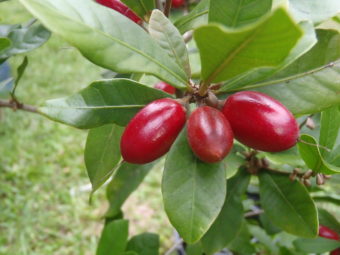The Curious Case of the Fruit That Transforms Sour to Sweet
 Growing on tall shrubs with dense foliage, the small, red, mildly sweet berries known as miracle fruit seemingly magically can turn sour flavors sweet.
Growing on tall shrubs with dense foliage, the small, red, mildly sweet berries known as miracle fruit seemingly magically can turn sour flavors sweet.
The plant that produces the berries, Synsepalum Dulcificum, is native to West Africa, where the fruit was traditionally used to sweeten palm wine and make soured cornbread more palatable. Growing best in acidic soil in tropical zones, the coffee-sized berries were introduced to Europeans by the explorer Chevalier des Marchais.
So how does it work? The exact mechanisms here aren’t fully understood, but, in a nutshell, the fruit gets its sweetening properties from miraculin, a glycoprotein in the berry that binds to sweet receptors on the tongue. As to how the miraculin then makes sour things taste sweet, it appears to relate to the pH of the miraculin (which is neutral) and sour foods (which are acidic). More specifically, when the miraculin binds to the sweet receptors in the tongue, it is mostly inert until it comes in contact with acidic substances. When that happens, the miraculin changes structure slightly, with the result being the sweet receptors it is bound to become activated.
Because miraculin binds so strongly to the sweet receptors on the tongue, the berry does not have to be eaten with the sour food, and the sweetening effect may last as much as 30-60 minutes after chewing the berries. The duration of the effect depends on factors including the concentration of the miraculin, how long it was in contact with the tongue and the concentration of the acid in the otherwise sour food.
Not a subtle effect, the perceived sweetness produced by the miracle fruit can be remarkable – equivalent to up to a 17% sucrose solution. For reference here, the equivalent sucrose solution for typical soft drinks is only about 10%. The effect is things like Tabasco sauce reportedly changing flavor to that of doughnut glaze, among a myriad of other weird taste alterations.
To date, the miracle fruit has yet to be developed into a commercially-viable non-caloric sugar substitute in the United States, although an attempt was made in the 1970s. However, the day before the product was to launch under the brand name Miralin, the FDA suddenly switched from original plans to classify it as generally recognized as safe (GRAS) to classifying it as a food additive (which meant years of further testing to be deemed safe). This was a highly controversial move given that the berries had been regularly eaten for centuries in Africa without apparent ill effect. The project backers lacked the funding to conduct the years of testing needed and Miralin ultimately folded.
However, because of the circumstances of the FDA’s decision-making process, it was suggested that the sugar industry flexed its political muscles to sabotage the project. As such, using the Freedom of Information Act (FOIA), Miralin ultimately requested documents related to the FDA’s processing of their product. Fanning the conspiracy theory flames, when the files were produced, most of the documents were inexplicably completely blacked out, and there was no mention anywhere of why the FDA suddenly chose to switch from a GRAS classification to classifying the substance as a food additive.
Whatever the case, the berry has been classified as a harmless additive in Japan, where researches are fiddling with it using recombinant technology. For instance, using genetic modification, they have managed to produce lettuce that expresses miraculin equivalent to one miracle berry with just two grams of lettuce leaves.
In 2009, an oncologist at Miami’s Mount Sinai Medical Center also filed an investigational new drug application with the United States Food and Drug Administration (USDA) for the use of the miracle fruit with chemotherapy patients. From anecdotal evidence, the oncologist had discovered that some patients found it helped counteract the metallic taste byproduct of chemotherapy.
If you liked this article, you might also enjoy our new popular podcast, The BrainFood Show (iTunes, Spotify, Google Play Music, Feed), as well as:
- That Time When the Elite of the Western World Rented Pineapples by the Hour
- Why Fruits Change Color and Flavor as They Ripen
- What Fruit is Juicy Fruit Supposed to Taste Like?
- The Fruit That Tastes Like Chocolate Pudding
- Why Can’t You Put Pineapple in Jello?
Bonus Fact:
- It should probably not be surprising that people in the United States, per capita, consume the most sugar; in fact, the average American ingests 126 grams (about 25 teaspoons or a half of cup) of sugar per day in one form or another. The next highest sugar-consuming countries are Germany and the Netherlands at 102.9 and 102.5 grams per average person, respectively.
| Share the Knowledge! |
|




